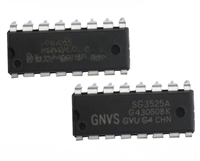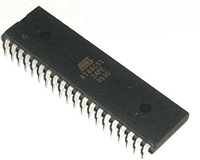AD8351
BASIC CONCEPTS
COMMON-MODE ADJUSTMENT
Differential signaling is used in high performance signal chains,
where distortion performance, signal-to-noise ratio, and low power
consumption is critical. Differential circuits inherently provide
improved common-mode rejection and harmonic distortion perfor-
mance as well as better immunity to interference and ground noise.
The output common-mode voltage level is the dc offset voltage
present at each of the differential outputs. The ac signals are of
equal amplitude with a 180° phase difference but are centered
at the same common-mode voltage level. The common-mode
output voltage level can be adjusted from 1.2 V to 3.8 V by
driving the desired voltage level into the VOCM pin, as illus-
trated in Figure 2.
1
2
3
4
5
PWUP
RGP1
VOCM 10
9
8
7
6
VPOS
OPHI
V
S
0.1ꢂF
A
A
INHI
V
1
2
3
4
5
PWUP
RGP1
VOCM 10
BALANCED
SOURCE
OCM
R
R
L
2A
G
1.2V
TO
3.8V
C
0.1ꢂF
INLO
RGP2
OPLO
DECL
9
8
7
6
VPOS
OPHI
COMM
INHI
BALANCED
SOURCE
R
R
L
G
Figure 1. Differential Circuit Representation
INLO
RGP2
OPLO
Figure 1 illustrates the expected input and output waveforms for
a typical application. Usually the applied input waveform will be
a balanced differential drive, where the signal applied to the INHI
and INLO pins are equal in amplitude and differ in phase by 180°.
In some applications, baluns may be used to transform a single-
ended drive signal to a differential signal. The AD8351 may also be
used to transform a single-ended signal to a differential signal.
COMM
Figure 2. Common-Mode Adjustment
INPUT AND OUTPUT MATCHING
The AD8351 provides a moderately high differential input
impedance of 5 kΩ. In practical applications, the input of the
AD8351 will be terminated to a lower impedance to provide an
impedance match to the driving source, as depicted in Figure 3.
The terminating resistor, RT, should be as close as possible to
the input pins in order to minimize reflections due to imped-
ance mismatch. The 150 Ω output impedance may need to be
transformed to provide the desired output match to a given
load. Matching components can be calculated using a Smith
Chart or by using a resonant approach to determine the match-
ing network that results in a complex conjugate match. The
input and output impedances and reflection coefficients are
provided in TPCs 19, 20, 22, and 23. For additional informa-
tion on reactive matching to differential sources and loads, refer
to the Applications section of the AD8350 data sheet.
GAIN ADJUSTMENT
The differential gain of the AD8351 is set using a single external
resistor, RG, which is connected between Pins 2 and 5. The gain
can be set to any value between 0 dB and 26 dB using the resistor
values specified in TPC 2, with common gain values provided in
Table I. The board traces used to connect the external gain resis-
tor should be balanced and as short as possible to help prevent
noise pickup and to ensure balanced gain and stability. The low
frequency voltage gain of the AD8351 can be modeled as
RL × RG 5.6 + 9.2 × R × R
RG × RL × 4.6 +19.5× RG + R + R × 39 + R
VOUT
VIN
(
)
F
L
A =
V
=
(
)
(
)
L
F
G
where: RF is 350 Ω (internal).
Figure 3 illustrates a SAW (surface acoustic wave) filter inter-
face. Many SAW filters are inherently differential, allowing for a
low loss output match. In this example, the SAW filter requires
a 50 Ω source impedance in order to provide the desired center
frequency and Q. The series L shunt C output network provides
a 150 Ω to 50 Ω impedance transformation at the desired frequency
of operation. The impedance transformation is illustrated on a Smith
Chart in Figure 4.
RL is the single-ended load resistance.
G is the gain setting resistor.
R
Table I. Gain Resistor Selection for Common Gain Values
(Load Resistance Is Specified as Single-Ended)
Gain, AV
RG (RL = 75 ꢀ)
RG (RL = 500 ꢀ)
0 dB
6 dB
10 dB
20 dB
680 Ω
200 Ω
100 Ω
22 Ω
2 kΩ
It is possible to drive a single-ended SAW filter simply by con-
necting the unused output to ground using the appropriate
terminating resistance. The overall gain of the system will be
reduced by 6 dB due to the fact that only half of the signal will
be available to the input of the SAW filter.
470 Ω
200 Ω
43 Ω
VPOS
L
S
R
T
190MHz SAW
27nF
R
R
0.1ꢂF
0.1ꢂF
0.1ꢂF
150ꢀ
0.1ꢂF
S
C
8pF
P
BALANCED
SOURCE
R
R
= R
AD8351
50ꢀ
G
S
T
L
S
S
R
T
27nF
Figure 3. Example of Differential SAW Filter Interface (fC = 190 MHz)
–10–
REV. B






 SG3525资料手册详解:SG3525参数分析、引脚说明、应用介绍
SG3525资料手册详解:SG3525参数分析、引脚说明、应用介绍

 AT89C51单片机资料手册详细解析及应用示例
AT89C51单片机资料手册详细解析及应用示例

 CP2102资料手册解读:CP2102引脚说明、关键参数分析
CP2102资料手册解读:CP2102引脚说明、关键参数分析

 资料手册解读:UC3842参数和管脚说明
资料手册解读:UC3842参数和管脚说明
